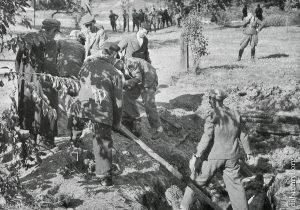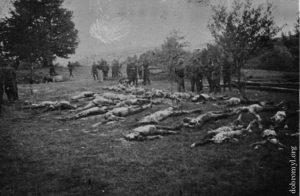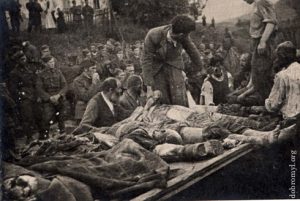Today, the mere mention of “Salina” evokes a sense of horror among the local population. Here, on June 22, 1941, the NKVD liquidated about 3,600 people - mostly intellectuals and young activists. There was not enough ammunition to kill all the individuals, so many were murdered by a hammer blow to the head and their bodies were thrown into the salt mine. The 100-metre pit was filled with human bodies. Local residents found 50 children among the dead.
Subsequently, soviet authorities built a sanatorium near the execution and burial area and also planned to construct... a dance floor. However, local residents rose up against the soviet officials and refused what they called the desecration of a memorial site.
Here is the story of yet another barbaric crime committed by Stalin’s NKVD.
On June 27, 1941, residents of Dobromyl uncovered a burial site near Salina containing the bodies of prisoners murdered by the NKVD. These were political prisoners from Dobromyl and Peremyshl (Przemyśl, today’s Poland) - Ukrainians, Poles, Jews – intellectuals and activists who refused to recognize the authority of the USSR. Children were also found; as of June 2015, about 3,600 bodies have been uncovered.

June 1941 - Special Operations in Western Ukraine
June 1941 has tragic significance for Western Ukrainians. In one week, close to 22,000 people were brutally executed by the communist regime on the entire territory of Western Ukraine.
When Hitler launched his armies against the Soviet Union, Moscow was faced with an enormous problem - what to do with thousands of prisoners, including so-called “enemies of the people”. The communist authorities were trapped and not able to evacuate the prisoners. Only one solution remained – operational and mass executions of all ideological enemies, including members of patriotic organizations, ordinary students, teachers, priests and businessmen – individuals that were considered dangerous to the Stalinist regime.
Estimates of the death toll vary between locations. The approximate number of prisoners executed in Western Ukraine from June 22 to June 30, 1941: Lviv (three prisons) - 4,000; Drohobych – 1,000; Dobromyl – 3,600; Zolochiv – 749; Stryy – 1,101; Sambir – 1,200; Demyaniv Laz – 2,500; Chortkiv – 800; Ternopil – 1,000; Lutsk – 2,754; Dubno – 1,500 and Peremyshl (Przemyśl) – 1,000. In other cities, the number of victims is measured by hundreds.

The road to hell
Salina is a silent memorial site testifying to the horrors of those days, and it is probably the least known to most Ukrainians.
As early as June 22, the first trucks with Polish and Ukrainian prisoners from Peremyshl (Przemyśl) arrived in the area. Mass executions began… What made the crime even more brutal was the fact that the victims were not executed by a firing squad, but their heads were smashed with sledgehammers used to crush rocks. The soviet troops lined up the men, who were bound with barbed wire, over the mine shaft. Then a NKVD soldier would deal a blow to the head and the victim would fall to the bottom of the shaft. Those who survived the blow would either drown in the salt or suffocate under consecutive layers of bodies. Only one man is known to have survived.

The NKVD separated the men from the women. The women were murdered in a chapel located near the mine. At the same time, the NKVD conducted a bloody massacre in the Dobromyl prison. Some of the prisoners were killed by a bullet to the back of the head, while others with blunt tools. People were killed in the courtyard, on the stairs and in their cells. Gallows were quickly set up in the timber yard. Thousands of prisoners from Przemyśl and local prisons were thrown into the pits, and dead bodies were brought in from nearby prisons.
On June 27, 1941, the inhabitants of Dobromyl uncovered a burial site near Salina containing the bodies of prisoners murdered by the NKVD. The pit was 36 metres deep; there were 77 bodies. 51 more bodies of prisoners were found in two temporary graves in the prison courtyard, and the remains of burnt corpses were discovered in the Main Forestry Building. The victims had been so violently beaten that many of them could not be recognized. The following persons were identified: Father Kebuza from the village of Makiv (his hands were broken and his tongue had been cut out); Mykola Vozny from the village of Liatsky (today’s Solianuvatka) (his body had been dismembered with bayonets). The NKVD executioners were identified by the local population: Head of the Town Council Petrovskiy, secretary of the District Party Committee Bubnov and local militiaman Kremer. It was also confirmed that the retreating soviet units killed UGCC priest Father Petro Dutka and five villagers in the nearby village of Knyazhpil.
In the early 1990s, researcher Mariya Prokopets started gathering testimonies from elderly survivors in the closest villages in order to maximally reproduce the history and chronology of those tragic events.
“In all my years of research, I’ve never seen such horror - throwing living, half-dead and dead people into a salt mine!” says Mariya Prokopets.

Testimonies
Liubomyra Bachara, a resident of the neighbouring village of Solianovatka, was eleven years old. She witnessed how the prisoners from Przemyśl were led to death.
“Suddenly, there was a lot of noise in the village; we ran out and saw a column of prisoners… My mother ran into the house, grabbed a loaf of bread, shouting to us that the prisoners should eat something. The line of prisoners dragged out through the whole village; we couldn’t see the beginning or the end of the column. They looked miserable and totally exhausted. Mom ran up and gave one of the prisoners a piece of bread. The others stretched out their gaunt arms…
Suddenly, a guard grabbed my mother’s shoulder and shouted: “What do you think you’re doing!?” Mama replied that she felt sorry for them and wanted to feed them. The guard got really mad, and pulled her into the line of prisoners. We started crying…
Then, another guard approached and said: “Let go of the old lady! Can’t you see the little kids are crying!?” But, he refused and started pulling us into the line of prisoners. Finally, some other guards ran up and took mother out… and so we were all saved from a terrible death!”
Liubomyra Bachara explained that the villagers had no idea where the prisoners were being taken. But, as they watched, the convoy turned and headed in the direction of the Salina salt mine. Another resident, Vasyl Fartushok, recalls some details of the convoy:
“What really sticks in my mind is a dignified elderly man in the last row of prisoners. He was wearing traditional Hutsul clothing... His trousers and woolen shirt were beautifully embroidered…”
The locals were afraid to follow the convoy. Later, they heard a constant rumbling noise of engines as a putrid cadaverous stench filled the air. They could only guess what was happening, and why the engines had been turned on to drown out other noise.

The villagers recall that the defile of army trucks was never-ending… night and day, they drove through the village. The villagers surmised that the bodies of dead prisoners were being brought from nearby and distant prisons to Salina for final “disposal”.
Eyewitnesses spoke in horror of the blood that ran from the passing trucks and soaked into the dirt roads of their village. A resident of Dobromyl, Yevheniya, born in 1927, was always afraid to testify, even in the 1990s when Ukraine declared its independence.
“I remember those days clearly, when large trucks with tarpaulin covers rumbled through the villages towards Salina. We watched from the windows, and Dad shouted: “Don’t look! They’ll shoot you!” We continued watching anyway. Suddenly, I screamed with terror; a leg with a blood-stained shoe emerged from under the tarpaulin of the truck that had just passed our house!”
The soviet authorities ordered the miners to stop all work in the mines so that there would be no direct witnesses to the mass burials. If anyone accidentally saw or witnessed these horrors, he was shot on the spot.
A 100-metre grave
The first Slovak reconnaissance teams arrived in Dobromyl with the German troops on June 27, 1941. When they learned about the Salina massacre from the villagers, they immediately began searching for the NKVD burial grounds.

Walking along the grass, which had been trampled by the long lines of prisoners, they discovered mounds of fresh soil and branches covering the mine shaft… and hundreds of bodies. Yevheniya shakes her head as she remembers:
“After the moskali (pejorative term for Russians-Ed) left our village, people began venturing from their houses. Suddenly, we see crowds of villagers running towards Salina. We follow them… But what I saw there is better left unsaid. In the garden, near the cherry trees, lay piles and piles of dirty clothes. There was blood everywhere... Someone went to look inside the church and suddenly, we heard an inhuman scream. We ran in that direction… And there, on the wall of the church we saw a crucified man…”
According to eyewitnesses, the church floor was covered in dried blood. But, the worst was yet to come… when the mine was uncovered. The deep pit was full of bodies. The German Command ordered the Jews of all the neighbouring villages to dig up the bodies. Only 500 bodies were recovered. Due to the terrible stench and extreme heat, the German authorities finally ordered the villagers to cover the mine as quickly as possible.

Dmytro Sokil, native of the village of Trushevychi remembers:
“On July 3, I was ordered to stand guard at Salina, where the Bolsheviks had executed and buried people even before the war. The Germans drove the Jews from our village to the mine and forced them to pull the bodies from the shaft. It was frightening to watch. They pulled the bodies out with hooks and laid them in rows. The faces of the victims were eaten away by salt brine.
I stood very close to the shaft, so I could see the bodies. I didn’t count how many bodies were removed that day, but I figured it was somewhere around 200-300. Then, they began pulling out body parts… pieces of human flesh. The stench was nauseating. Finally, the Germans ordered the workers to stop, poured some sort of substance into the mine and cemented the shaft opening.”
Ivanna Kruk-Krasnevych, born in Dobromyl, recalls those horrible days:
“The Jews were forced to pull human remains from the mine and lay them in rows. People came from all around to identify friends and relatives.
They dug a deep hole on the mountain and buried the bodies there. The exhumation continued for two whole weeks. When the hole was filled with bodies, young boys and girls arrived from nearby villages to work on filling the mine shaft with soil and erecting a grave.”
500 bodies were reburied several hundred metres from the mine; a cross was placed on the mound.

To honor the memory of the Ukrainian and Polish prisoners of the NKVD, a Memorial March was organized on April 27-28, 2012. Ukrainian youngsters from Stary Sambir Raion and Polish teens from Przemyśl region solemnly retraced the steps of the prisoners, from Przemyśl, Poland to Salina-Dobromyl, Ukraine.
Photo gallery of the Salina Memorial Complex. All photos: Dobromyl.org













